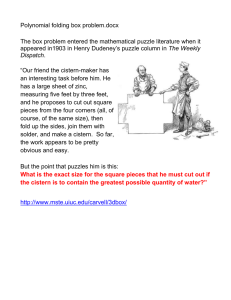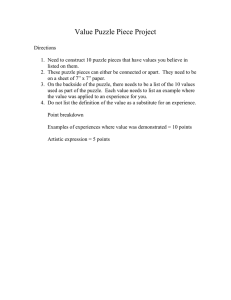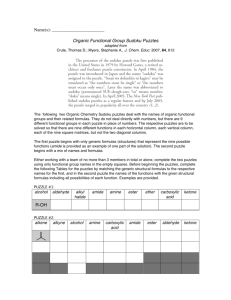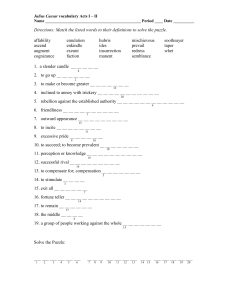Animals, Piece by Piece
advertisement
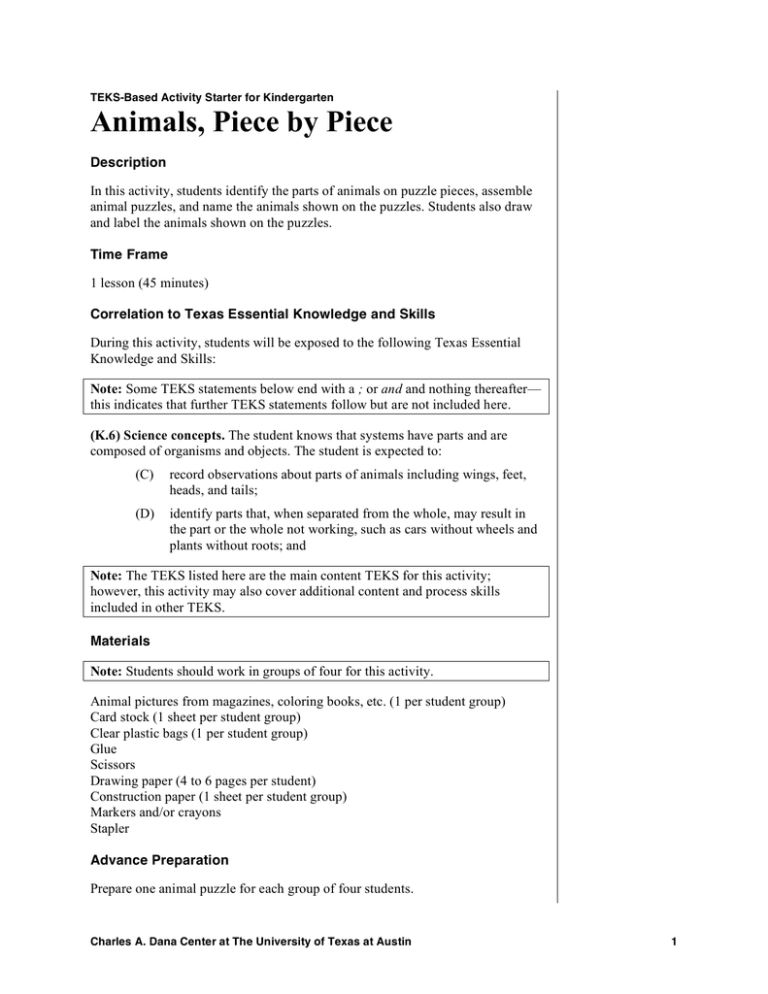
TEKS-Based Activity Starter for Kindergarten Animals, Piece by Piece Description In this activity, students identify the parts of animals on puzzle pieces, assemble animal puzzles, and name the animals shown on the puzzles. Students also draw and label the animals shown on the puzzles. Time Frame 1 lesson (45 minutes) Correlation to Texas Essential Knowledge and Skills During this activity, students will be exposed to the following Texas Essential Knowledge and Skills: Note: Some TEKS statements below end with a ; or and and nothing thereafter— this indicates that further TEKS statements follow but are not included here. (K.6) Science concepts. The student knows that systems have parts and are composed of organisms and objects. The student is expected to: (C) record observations about parts of animals including wings, feet, heads, and tails; (D) identify parts that, when separated from the whole, may result in the part or the whole not working, such as cars without wheels and plants without roots; and Note: The TEKS listed here are the main content TEKS for this activity; however, this activity may also cover additional content and process skills included in other TEKS. Materials Note: Students should work in groups of four for this activity. Animal pictures from magazines, coloring books, etc. (1 per student group) Card stock (1 sheet per student group) Clear plastic bags (1 per student group) Glue Scissors Drawing paper (4 to 6 pages per student) Construction paper (1 sheet per student group) Markers and/or crayons Stapler Advance Preparation Prepare one animal puzzle for each group of four students. Charles A. Dana Center at The University of Texas at Austin 1 TEKS-Based Activity Starters Kindergarten—Animals, Piece by Piece 1. Collect several animal pictures from magazines, coloring books, or other sources. It is best for this activity to choose pictures of animals that have arms or wings, legs, head, and tail, and pictures that are large enough to be cut and reassembled as a puzzle. 2. Mount each animal picture with glue on a piece of card stock. 3. Cut each mounted animal picture into four parts, if possible making the four parts show legs, arms or wings, head, and tail. 4. Place each four-part animal puzzle in a clear plastic bag. 5. Make an animal journal for each student by stapling four to six pieces of drawing paper into a construction-paper cover labeled Animal Journal. Procedures 1. Divide students into groups of four and give each group an animal puzzle in a plastic bag. 2. Each student should pull one puzzle piece from the bag and name the animal part shown on the puzzle piece. 3. Student groups should assemble the puzzle pieces to complete the animal and then name the animal. 4. Post the names of the puzzle animals and their parts on sentence strips, an overhead, a poster, or the chalkboard. 5. After student groups complete one puzzle each, collect the puzzles and redistribute them, giving different animals to different groups. Repeat this process until all groups have worked with all puzzles. 6. Give students their animal journals and ask them to draw pictures of the animals shown in their puzzles and label the animals’ parts. If there is not time for students to draw all the animals in all the puzzles, allow them to choose which animals they want to draw. The teacher may help record the students’ words. 7. Optional: Place the puzzle bags in the classroom science center so students can practice further. Assessment Activity Observe which parts and the functions of those parts each student can name. Formal assessment for this age group is not recommended, but observe which animal parts and functions each student can name. It might help to use a checklist like the one below while observing the students The student can 1. Name the animal. 2. Name the parts of the animal: Charles A. Dana Center at The University of Texas at Austin 2 TEKS-Based Activity Starters Kindergarten—Animals, Piece by Piece Arms/Wings Legs Head Tail 3. Explain at least two of the parts. 4. Explain what might happen if a part was removed. Extension Find pictures of animals that do not have arms, wings, or legs, such as snakes or worms. Ask students how these animals move without having the parts they studied in the puzzles. Additional Reading Resources Following is a list of books useful for introducing students to how animals use different parts of their bodies. Carolyn Sherwin Bailey. The Little Rabbit Who Wanted Red Wings. New York: Grosset & Dunlap, 2001. Eric Carle. The Mixed-Up Chameleon. New York: HarperTrophy, 1988. Anita Ganeri. Creature Features. New York: Simon & Schuster, 1997. Fred Gwynne. A Little Pigeon Toad. New York: Aladdin Publishing, 1990. Bill Peet. No Such Things. Boston: Houghton Mifflin, 1983. Nicola Tuxworth. Let’s Look at Animals. London: Anness Publishing, 1996. Charles A. Dana Center at The University of Texas at Austin 3
